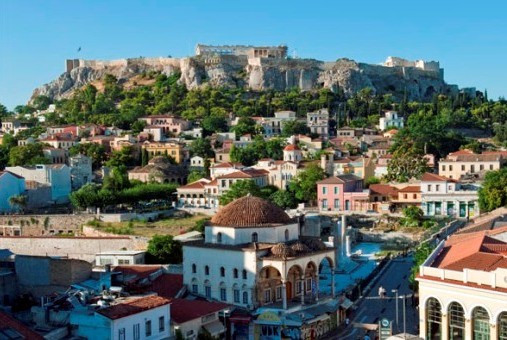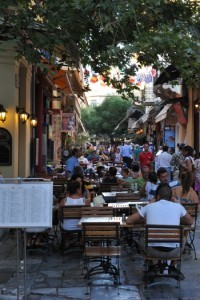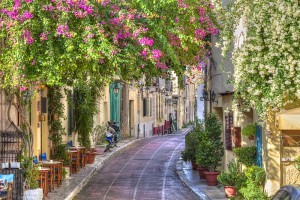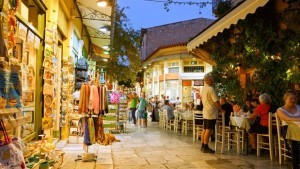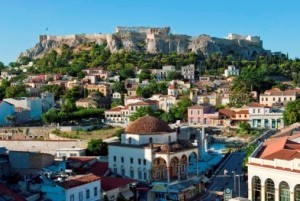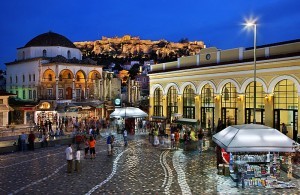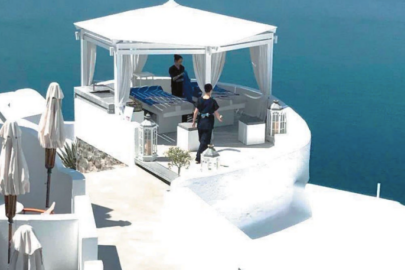It is the oldest district in Athens (it is also mentioned as “Gods’ district”) with outstanding scenery. The moment you start walking on its paved narrow lanes you get the feeling that you travel back in time.
Nobody knows where the area took its name from. According to the most prevalent opinion, Plaka took its name from a large stone slab that was found in the area near to Aghios Georgios Alexandreias church, next to Dionysus ancient theater.
You will be mesmerized by the beauty of the houses with neoclassic colors, the architecture, the well-preserved gardens, the elegance and the atmosphere of the whole area.
Even Plaka’s air is different: Softer, clearer and full of scents, like a gift from gods. If you decide to walk around the area, make sure you have a map, because Plaka is like a labyrinth and you will probably get lost in its lanes.
You will find souvenir shops in the central street of the district Adrianos Str., as well as in other streets.
Sightseeing:
Filomousos Eteria Square. The central square of the area that took its name from Filomousos Eteria (Association of Muses’ Friends – Muses where the 9 goddesses of Arts) and was constructed in 1813. The aim of this Association was to promote Greek Studies and preserve Athens archeological treasures.
The square is located in the intersection of Kydathinaeon, Farmaki, Olympian Zeus and Aggelos Gerontas streets and is full of coffee houses, restaurants and clubs with live music. There are also many souvenir shops.
Children Museum. It is located in Kydathinaeon Str. and is a children paradise. In the attic you can visit its renovated room full of old furniture, a radio and an old Athenian house stove. It is called the “grandfather’s and grandmother’s room” and the children visiting it can try on some old traditional costumes. There is also a gallery of children paintings and old toys, a playground, a library etc. If you have children, you should not miss visiting this museum.
It is also worth to visit the neighboring Museum of Greek Children Art (9 Kodrou Str.), where apart from some educational events that the museum organizes, paintings and constructions of children aged 4-14 from all over Greece are exhibited. These paintings are often replaced with new ones.
Choragic Monument of Lysicrates. In ancient Athens, all theater performances organized in Dionysus Theater, were subsidized by wealthy citizens who were called chorigoi (or sponsors). The sponsor of the best performance was awarded with a prize. When Lysicrates, a wealthy man, won this prize (334 B.C.), he decided to construct a monument to house his prize. This monument is still preserved (located in ancient Tripodes Str., and its paving is preserved in a room of a renovated building number 28). The monument’s construction was just the beginning of a long-lasting history of this creation. In 1658, Cappuccinos monastery was built there and in 1669 the monument was bought by Cappuccinos. Lord Byron stayed in this monastery during his second visit to Greece, while tomatoes were first planted in its garden.
Anafiotika. It is a beautiful island village on the foot of Acropolis Rock! It was constructed in the middle of the 19th century, when builders came to Athens from the Aegean island of Anafi. These builders were considered as the best in their art and came to Athens to construct the Palace of the first King of Greece, Othonas. Knowing that they would have to spend few years away from home and feeling nostalgic, they decided to reconstruct their village on the highest area of Plaka. So they built small white houses, with the same architectural style as the ones in their village. Anafiotika, which means the neighborhood of Anafiotes (people from Anafi), is a unique and beautiful must see area.
Athens University Museum: This building in Tholos Str. initially was the house of architect Kleanthis (1832-1833) and afterwards it housed Athens first University (1837-1842). Nowadays, it houses Athens University Museum.
Kanellopoulos Museum: It was built in 1976, after the donation of Pavlos and Alexandra Kanellopoulos private collection to the Greek State. It is housed in the neoclassic house of Michalea family. Kanellopoulos collection includes archeological findings and works of art dating back to the prehistoric period until now.
Source: visitgreece

